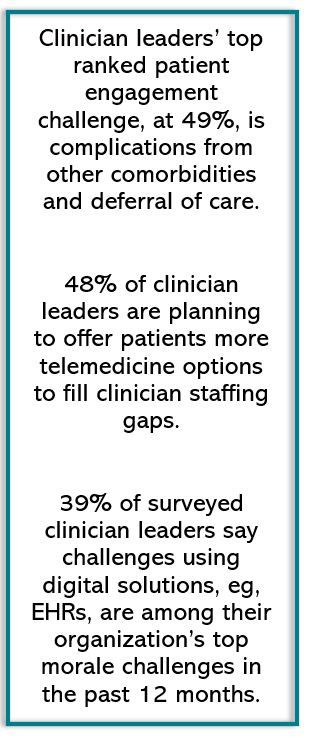- Clinical Technology
- Adult Immunization
- Hepatology
- Pediatric Immunization
- Screening
- Psychiatry
- Allergy
- Women's Health
- Cardiology
- Pediatrics
- Dermatology
- Endocrinology
- Pain Management
- Gastroenterology
- Infectious Disease
- Obesity Medicine
- Rheumatology
- Nephrology
- Neurology
- Pulmonology
Is Technology the Answer to Revitalized Primary Care?
Health care leaders increasingly are looking to technology for solutions to the challenges facing primary care.
©ibreakstock/stock.adobe.com

Clinicians are in the midst of a deep staffing crisis, with 63% of clinician leaders citing clinician turnover and understaffing as top morale challenges, according to BDO’s 2023 Clinician Experience Survey. This problem is exacerbated by an aging workforce and a decline in students opting to attend medical school.
The shortage is particularly challenging for primary care, with medical students increasingly choosing more lucrative career paths, such as those in specialties, as well as in biotech and pharmaceuticals. In fact, the U.S. may experience a shortage of up to 48,000 primary care physicians by 2034, according to a report from the Association of American Medical Colleges.
The Clinician Experience Survey found that clinician leaders are attempting to address burnout and morale challenges by using technology to fill staffing gaps and reduce the administrative burden on clinicians. The survey also showed that technology can help improve patient engagement, a crucial benefit for primary care physicians right now, with as many as 1 in 3 Americans reporting they don’t see a primary care doctor.
Improving the clinician experience
Technology can reduce the burden placed on primary care physicians and improve their efficiency, allowing them to focus on high-impact patient care rather than dealing with simple inquiries and paperwork. Fifty-one percent of Clinician Experience Survey respondents say they plan to fill clinician staffing gaps in the next 12 months by increasing the automation of patient communications, making this the most popular strategy. Automated responses to simple questions, powered by generative artificial intelligence (AI) with review by a clinician, can help patients stay engaged with their primary care while reducing the workload for clinicians.
To answer more complex patient inquiries, some health care providers are implementing dedicated virtual health service lines and tapping advanced practice practitioners for additional information as needed, so primary care physicians aren’t overwhelmed with both in-person and virtual patient care loads. As a result, 48% of clinician leaders are planning to offer patients more telemedicine options to fill clinician staffing gaps.
When seeking to help clinicians through technology, health care leaders should make sure the technology is well-integrated and user-friendly. A well-intentioned digital solution, if poorly planned, can inadvertently increase administrative burdens and frustrations for clinicians, staff, and patients. In fact, 39% of surveyed clinician leaders say challenges using digital solutions, including electronic health record (EHR) systems, are among their organization’s top morale challenges in the past 12 months.

Improving patient engagement
Clinician leaders’ top ranked patient engagement challenge, at 49%, is complications from other comorbidities and deferral of care. When patients do access care, getting them to stick with it can also be tricky. The second-ranked patient engagement challenge, selected by 48% of leaders, is encouraging patient adherence to treatment plans.
Due to their central role in patient care, primary care clinicians are in a unique position to maintain and increase patient engagement. However, according to BDO’s 2022 Patient Experience Survey, only about 69% of patients have a primary care physician. According to the survey, 40% of clinician leaders say establishing and reestablishing primary care relationships is one of their greatest patient engagement challenges.
With the aid of digital tools, primary care clinicians can help patients stay engaged with their care. Patient self-scheduling and self-service through online portals, rather than a call center, reduces the effort needed for patients to access care. Sixty-one percent of clinician leaders say that use of these systems is their top planned method for increasing patient engagement.
But challenges persist even after an appointment, as primary care physicians cannot always ensure patients follow their treatment plan. To increase patient engagement, 48% of clinician leaders plan to introduce or increase remote patient monitoring and treatment capabilities. Forty-four percent plan to introduce follow-up check-ins to increase patient engagement, which can be performed remotely, making it easier for patients to adhere to their treatment plans.
Finally, a primary care physician can serve as a concierge for care, issuing referrals for specialists and managing treatment progress across multiple providers. Forty-eight percent of clinician leaders plan to increase patient engagement by leveraging interoperability with other health services to facilitate treatment across modalities.
Revitalizing primary care
Despite the importance of primary care to overall population health, not all health care organizations are investing in its growth. As more patients turn to retail clinics and local urgent care centers for their health care needs, health care systems are experiencing increasing disruption in care retention and increasing cash flow pressures. Health care organizations need to recognize the value of their primary care assets when considering where to place their investments.
Divesting in primary care could reduce the resources the next generation of primary care physicians have to treat patients. A tougher primary care working environment, supported by fewer clinicians, could push more medical school students to pursue other modalities and worsen the severity of current morale challenges. Primary care divestments can also negatively impact patient populations: When primary care access deteriorates, overall population health outcomes are likely to decline in tandem.
Investing in technology can make it easier for primary care clinicians to provide high-quality care and improve patient access to that care. From user-friendly EHR systems to automated patient communications and dedicated telemedicine service lines, well-integrated technologies may be the key to the long-term sustainability of primary care.
This commentary originally appeared on our partner site Medical Economics®
Brad Boyd, MBA, is principal and national co-leader of the BDO Center for Health care Excellence & Innovation
